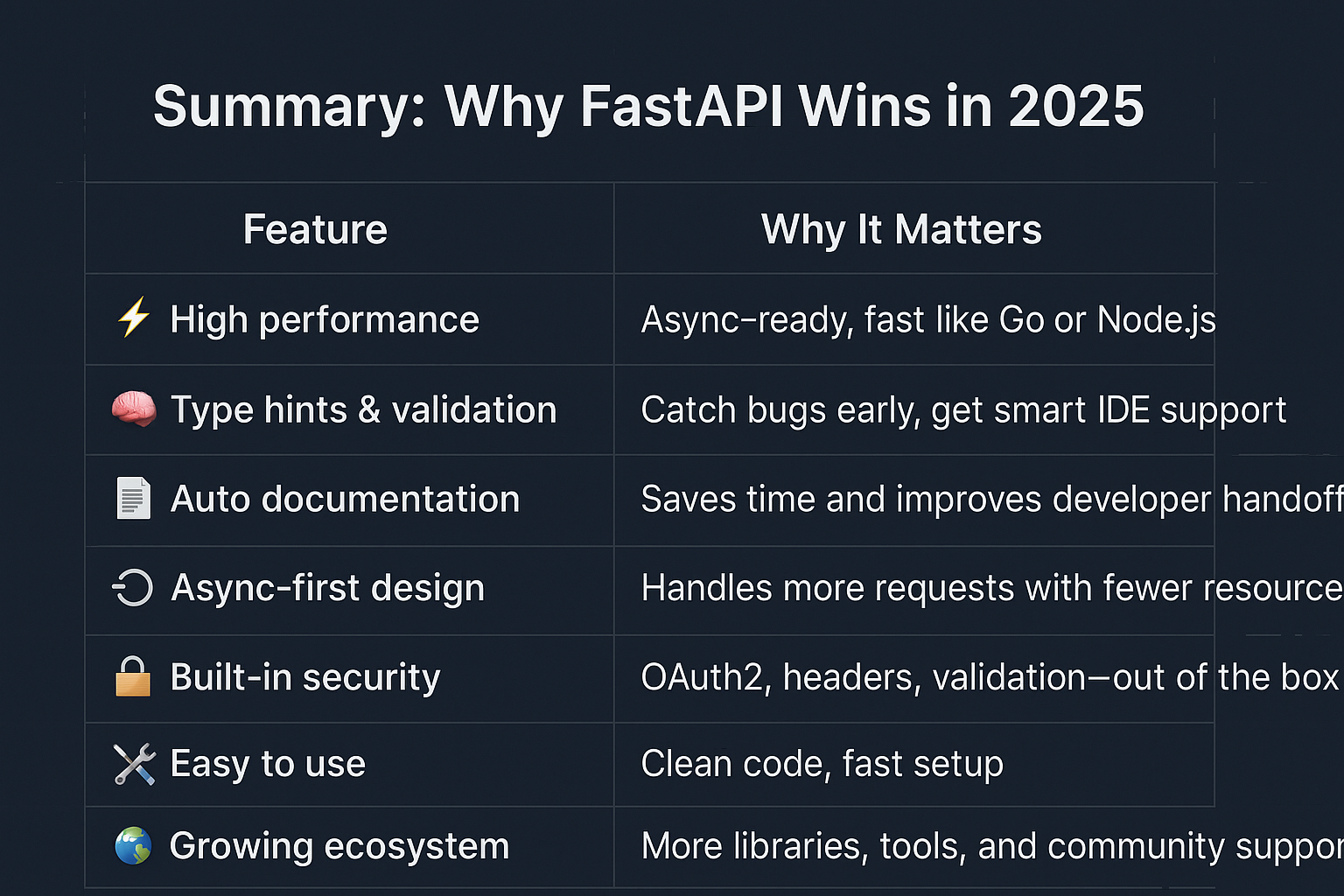Introduction
In today’s digital world, APIs are everywhere. From social apps and payment gateways to AI services and microservices—modern software depends heavily on fast, reliable APIs.
Enter FastAPI — the high-performance Python web framework that's quickly becoming the go-to choice for developers building modern web services in 2025.
But what exactly makes FastAPI so popular? Let’s break it down.
What is FastAPI?
FastAPI is an open-source web framework for building APIs using Python 3.7+. It is built on top of Starlette (for the web parts) and Pydantic (for data validation), offering asynchronous support, type hints, and automatic docs generation out of the box.
In short, FastAPI is:
- Fast – Really fast. Comparable to Node.js and Go.
- Pythonic – Uses modern Python features like type hints.
- Async-ready – Handles thousands of requests efficiently.
- Automatic – Generates OpenAPI and Swagger docs automatically.
Why Developers Are Choosing FastAPI in 2025.
1. Blazing Fast Performance
FastAPI is one of the fastest Python frameworks out there.
- Built on Starlette, it supports asynchronous I/O, which means it can handle multiple requests at the same time.
- Perfect for APIs that require real-time communication, such as chat apps, IoT services, or live dashboards.
- Outperforms Flask and Django in many performance benchmarks.
“Performance matters when you're building scalable services. FastAPI delivers speed without compromising simplicity.”
2. Type Hints = Smart Developer Experience
FastAPI embraces Python’s type hints to offer:
- Editor support (autocomplete, linting).
- Runtime validation of request and response data.
- Fewer bugs, better code readability, and stronger typing.
This makes the development process clean, intuitive, and reliable.
3. Automatic API Documentation
FastAPI automatically generates interactive API documentation using:
- Swagger UI – for testing endpoints visually.
- ReDoc – for clean, read-only API specs.
No extra setup required. This is a huge time saver for backend teams and also makes life easier for frontend teams and third-party integrators.
4. Async-First, But Sync-Friendly
FastAPI is built from the ground up with async/await support:
- Efficient for handling high-throughput apps.
- Works great with databases like PostgreSQL, Redis, and NoSQL tools using async drivers.
- Still works well with sync code, making it flexible for teams migrating from older frameworks.
5. Built-In Validation and Security
Thanks to Pydantic, FastAPI provides:
- Powerful and automatic data validation.
- Clear error messages when input data is invalid.
- Easy handling of headers, cookies, and OAuth2 authentication.
Security is baked in with minimal code.
7. Huge Ecosystem and Community Growth
FastAPI may be young compared to Flask or Django, but it’s growing rapidly:
- Backed by large companies and used in production (Netflix, Microsoft, Uber).
- A growing number of plugins and extensions (database ORMs, task queues, admin panels).
- Tons of community tutorials, starter templates, and GitHub projects.
Real-World Use Cases of FastAPI in 2025
FastAPI is powering everything from small tools to large-scale services:
- AI APIs – ML model deployments using FastAPI + Pydantic.
- Fintech microservices – High-throughput and secure.
- Healthtech apps – Where data validation and performance are critical.
- IoT platforms – Managing thousands of concurrent connections.
Its use across domains makes it a safe and scalable choice.
Summary

Final Thoughts.
In a world where APIs are at the heart of every digital product, FastAPI offers the ideal mix of speed, developer happiness, and scalability.
It’s not just a trend—it’s a thoughtful evolution of how APIs are built in Python.
Whether you're building a quick MVP or designing the backend of a large distributed system, FastAPI is the tool that gives you the performance of Go with the readability of Python.
If you haven't tried it yet, 2025 is the perfect time to start.
If you need any assistance building APIs with FastAPI, reach out to our team at Asistensia.We’re here to help.
Written by Ahmad
Full Stack-Engineer
